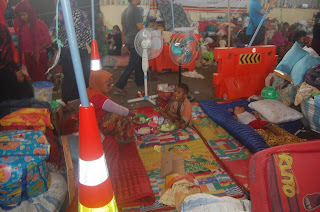I heard of Vipassana,
“Jing Guan” in Mandarin, around four years ago when I was in Hong Kong studying
Social Work and always expect to have a try.
Although I did not really understand the concept, I thought it was
related to “here and now”, “feeling and sensation”, and “awareness”, all of
which help to reframe the mindset and regain the inner peace.
When I was
introduced by a friend that there is Vipassana Meditation Centre in Sunshine
Coast, Queensland, Australia, and they regularly organize ten-day free
Vipassana Meditation Course, I was so surprised and excited to have a try. I was surprised because I knew Vipassana came
from the East and I met it in the West.
I was excited to try because Sunshine Coast is only two-hour drive from
Brisbane and is famous for its fantastic beaches and the landscape.
I immediately
applied for the ten-day meditation courses without any hesitation and I treated
it as a normal workshop, which meant I would learn meditation skills from the
teachers and experience the peaceful and relaxed meditation sessions in a
beautiful centre. I did not read the
course information carefully before I applied for it. All my imagination about the courses was not
wrong, but they were not the full picture.
"The technique of
Vipassana meditation is a practical way to achieve peace of mind and live a
happy, productive life. It is learned by attending a 10-day residential course
with a qualified teacher where the student is free from distractions so that
the reality within can be observed. " (Vipassana Meditation Course: http://www.dhamma.org.au/)
The ten-day
experience is really unforgettable. I would like to record some of my feeling
at that time to remind myself that I once had such an interesting experience.
“Precept One: to abstain from killing any
being”
Day 0: I always treat it as a course, but when I mention
I cannot use internet or mobile phone for ten days during the course, my
friends think it is like a retreat and I will not learn something seriously. Maybe they are right, and anyway, I do prefer
a good rest. My only concern is that I
will feel hungry all the time and my stomach will be in pain since they only
provide vegetarian food and there will be no dinner, only fruits and the milk
tea for the evening break. Finally, I hide some bananas, chocolates and nuts in
my bag to attend the course, and I find an excuse for myself, “it’s just in
case I need them.”
“Noble silence: Noble Silence means silence
of body, speech, and mind. Any form of communication with fellow student,
whether by gestures, sign language, written notes, eye contact etc., is
prohibited.”
Day 1: I feel I am
living in the film, Shutter Island. Everyone follows noble silence, no any form
of communication, even no eye contact among each other. During the break, most of the students just
stand or sit on the lawn watching the sky, the clouds, the mountain, the trees,
the flowers, the birds or the group of Kangaroos, for a long time, since
besides that, there is almost nothing to do.
According to the rule, no reading, no writing, no workout, no Internet,
no phone is allowed during the ten days.
Walking in the garden is fine, but only in the day time.
“Daily schedule: The meditation sessions
starts at 4:30 am and ends at 9 pm, totally 12.5 hours per day. “
Day 2: I realize that the meditation courses will be getting
harder and harder, since I need to sit still and move as less as I can for 12.5
hours per day. It is definitely hard
work and I did not expect that practicing meditation can cause pain for my neck
and shoulders. Where is the promised
relaxation?
“The teacher said, since you decide to spend
10 days of your life here, try to work diligently to gain as much as you
can. Work diligently and properly and
keep practicing.”
Day 3: The teacher’s
words are convincing. I ask myself to
work diligently for the 10 days. Today I feel I am getting used to the practice
and I am being less impatient.
Meanwhile, the practice of observing my breath in and out is becoming
more and more interesting. I am an
outsider of my breath, which means I cannot control it and can only observe
it. Let it come; let it go; let it
be. What surprises me most is the
practice is sharpening my sensation and I am able to feel more subtle
sensations.
Day 4: After one
day’s practice, during the evening break, I feel I need to talk to the female
manager. I feel the pain of my stomach
and it is the real pain. I want to
figure out what is wrong with my body. “Nothing
is wrong and it is normal. Just observe
it and the pain will pass.” She is right.
“4.30 to 6.30 am: Meditation in the hall or
in your room; 6.30 to 8.00 am: Breakfast break.”
Day 5: I find it is
almost impossible to meditate in my own room from 4.30 to 6.30 am, since it is
very cold in my room in the early morning.
I prefer to go to the hall where I can concentrate on the techniques of
Vipassana much better. After the first
four days, I realize my favorite time here is the breakfast break. Usually, I spend 30 minutes for a simple
breakfast which means I eat as slowly as I can to appreciate the food and have
a good rest. Then I spend the rest of
time to have a morning walk in the bushes surrounding the centre. The morning sunshine in the bushes is really
fresh and sometimes I share the bushes with a group of kangaroos. I feel peace and joy during the morning walk.
Day 6: I feel I
miss home very much. The only thing I can do is to let the feeling in and let
it out.
“5 to 6 pm: Tea break.”
Day 7: It is really
nothing to do during the tea break in the evening. It is too dark to walk in the bushes. It is too boring to be in the room. I decide to wash my clothes, although I bring
enough clothes for ten days.
Day 8: Finally I
can feel some subtle sensations when practicing. From the fourth day, there were only gross
sensations, especially severe tension on the back and shoulders. I am so curious to know where they come from
and how to accept them as normal, rather than bad sensations. It is not hard to understand it by mind, but
it is really hard to let the body feel it. “The
truth is everything is changing, including our own sensations.”
Day 9: I start to
miss the passing days here, especially the morning walk, the time watching the
group of kangaroos, as well as the feeling of nothing to do.
Day 10: Nobel
silence is over and students start to talk with each other. I start to feel the
pressure of social, so do the kangaroos.
They just disappear in the bushes and it is hard to believe they came to
the centre every day during the Nobel Silence.
After the course: I
cannot believe I had ten days living like a nun. I realize I had many misunderstandings about
the life of nuns and monks. Although it
is only a simple life, actually, it is very hard to keep living in that way until
we find the way to reach the inner peace.












